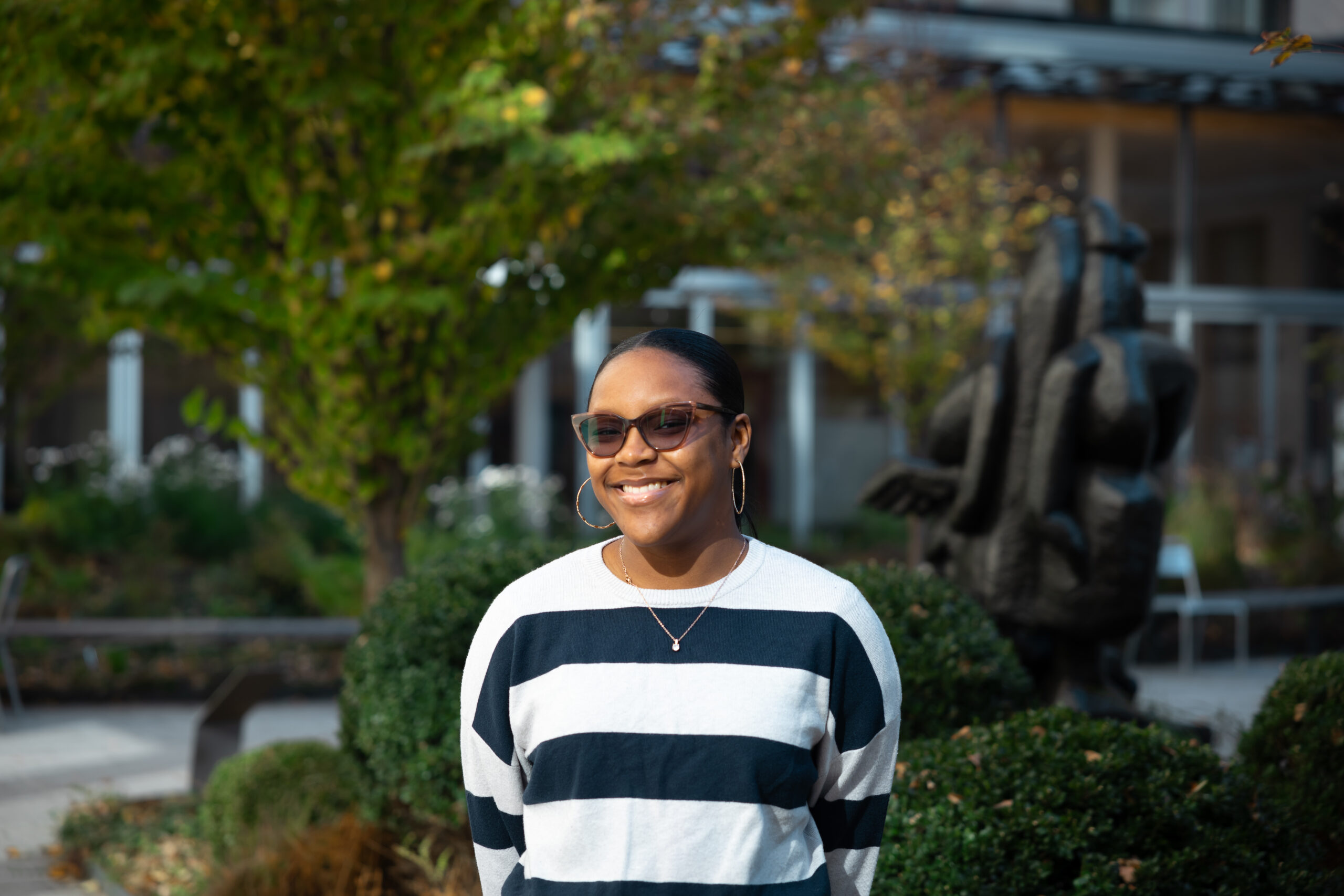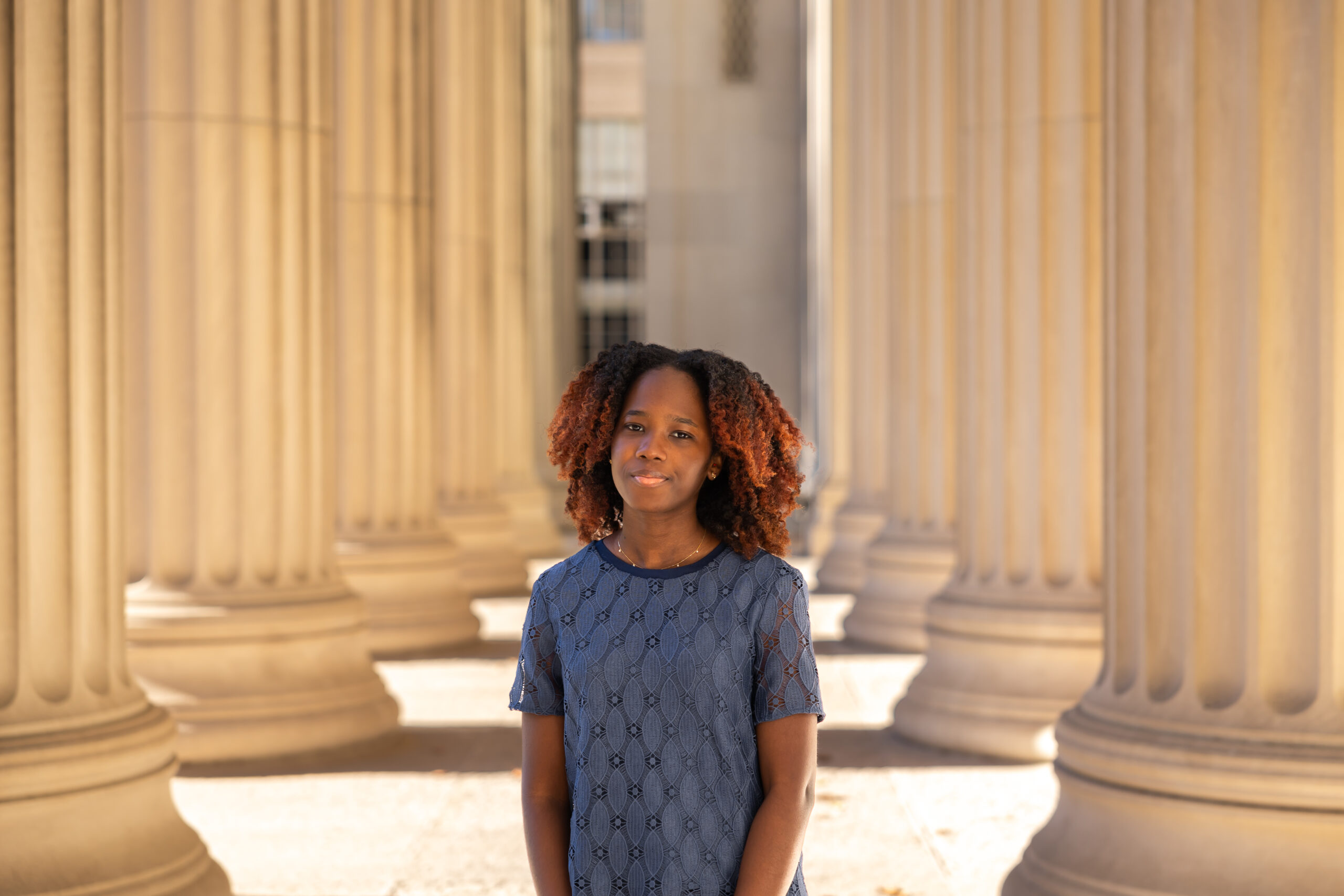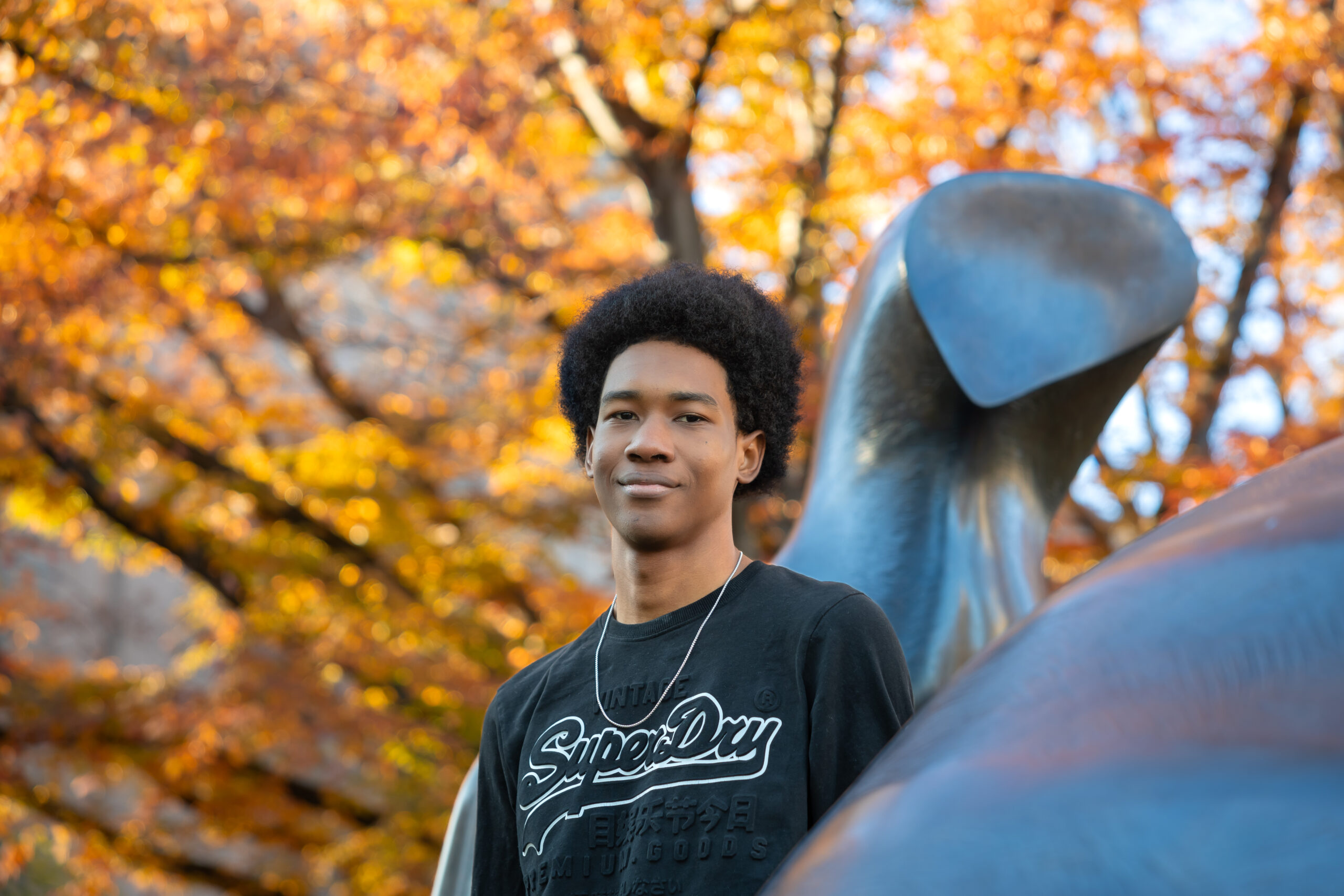A launching pad towards possibility: SPISE alumni at MIT
 “Attending SPISE completely changed my trajectory,” says Gerard Porter, who credits the five-week program with increasing his self-confidence, reasoning skills, and love of science. “Being exposed to other Caribbean high school students with backgrounds like mine who were ambitious enough to dream about attending some of the best institutions of higher learning in the world encouraged me to believe in myself.” Image credit: Frankie Schulte.
“Attending SPISE completely changed my trajectory,” says Gerard Porter, who credits the five-week program with increasing his self-confidence, reasoning skills, and love of science. “Being exposed to other Caribbean high school students with backgrounds like mine who were ambitious enough to dream about attending some of the best institutions of higher learning in the world encouraged me to believe in myself.” Image credit: Frankie Schulte.
When you ask MIT students to tell you the story of how they came to Cambridge, you might hear some common themes: a favorite science teacher; an interest in computers that turned into an obsession; a bedroom decorated with NASA posters and glow-in-the-dark stars.
But for a few, the road to MIT starts with an invitation to a special summer program: not a camp with canoes or cabins or campgrounds, but instead one taking place in classrooms and labs with discussions of Arduinos, variable scope and aliasing, and Michaelis-Menten enzyme kinetics. The classroom and labs are in Barbados at the Cave Hill campus of the University of the West Indies, and all the students are gifted Caribbean high schoolers, ages 16-18, who’ve been selected for the extremely competitive Student Program for Innovation in Science and Engineering (SPISE). Their summer will not include much time for leisure or lots of sleep; instead, they’ll be tackling a five-week high-intensity curriculum with courses in university-level calculus, physics, biochemistry, computer programming, electronics and entrepreneurship, including hands-on projects in the last three. For several students currently on campus, SPISE was their gateway to MIT.
“The full story is even bigger,” says Cardinal Warde, Professor of Electrical Engineering, the founder of SPISE and originally from Barbados in the Caribbean. “Over the past 10 years, exactly 30 of the 245 students in total from the SPISE program have attended MIT as undergrads and/or graduate students.”
While many SPISE alumni have gone on to Harvard, Stanford, Caltech, Princeton, Columbia, U Penn and other prestigious schools, the emphasis on science and technology creates a natural pipeline to MIT, whose faculty and instructors volunteered their time and expertise to help Warde design a curriculum that was both challenging and engaging.
Jacob White, the Cecil H. Green Professor in Electrical Engineering, was one of the first of those volunteers. “When COVID forced SPISE to run remotely, Professor Warde felt it was critical to continue having hands-on engineering labs, and sought my help,” White explains. “Kits were cobbled together using EECS-donated microcontroller boards, motors and magnets; Dinah Sah (the SPISE director) got those kits to students spread over half-a-dozen islands.” White, and several of his graduate students, collaborated to write a curriculum which would give the students enough grounding in fundamentals to empower them to create their own designs.
When SPISE returned to in-person education, Steve Leeb, Emanuel E. Landsman (1958) Professor in the Department of EECS and a member of the Research Laboratory of Electronics (RLE), was inspired by the challenge of teaching electronics remotely.
“SPISE is exactly the kind of opportunity we’re looking for in the RLE educational outreach programs: bright, enthusiastic young folks who would benefit from new perspectives on science and engineering — a community of folks where we can bring new perspectives, share energy and excitement, and, ideally, make lifelong connections to our academic programs here at MIT. It’s a natural fit that benefits us all,” says Leeb, who, together with his graduate students, adapted the portable “take-home” Electronics FIRST curriculum pioneered at MIT and taught in course 6.2030. “The Electronics FIRST exercises and lectures are designed to connect electronic circuit techniques – digital gates, microcontrollers, and other electronics technologies – that are recognizable as elements of commercial products,” says Leeb. “So the projects naturally engage students in building with components that have a connection to commercial products and product ideas. This flows naturally into a “final project” that the students create in SPISE, a product of their own conception, for example a music synthesizer.”

Crucially, the curriculum isn’t simplified for the high school students. “We adapted the projects to fit the different program length – SPISE is shorter than a full MIT term,” says Leeb. “We did not reduce the rigor or challenge of the activities, and, in fact, have brought new ideas from the SPISE students back to campus to improve 6.2030.”
Departments beyond EECS pitched in to develop SPISE, with major teaching contributions coming from the Department of Physics, where Alex Shvonski, Lecturer; Caleb Bonyun, Senior Technical Instructor; and Joshua Wolfe, Senior Technical Instructor and Manager of the Physics Instructional Resource Lab, collaborated on developing hands-on projects and on the teaching for both Physics I and Calculus I courses. Additional supplies came from the MIT Sea Grant Program, which supplied under-water robots to SPISE for six consecutive years before the COVID-19 pandemic. (After COVID, the program pivoted to focus on embedded systems.)
But the core inspiration for SPISE doesn’t come from an academic department at all. “SPISE was based on a model that’s proven to work: MITES,” explains Ebony Hearn, executive director of the MIT Introduction to Technology, Engineering, and Science. “The program, which offers access and opportunity to intensive courses in science, technology, engineering, and math for talented high school students in every zip code, has helped thousands of students for nearly 50 years gain admission to top universities and pursue successful careers in STEM while being immersed in a community of caring mentors and leaders in the profession.”
The shared DNA of the two programs is no coincidence. Cardinal Warde has been the Faculty Director of MITES for the past 27 years, and took the lessons of five decades of the transformative pre-college experience into account when envisioning an equivalent program in the Caribbean. Much like MITES, SPISE encourages its participants to develop a sense of belonging in STEM and to picture the possibilities at top schools; over the years, the program has added sessions with admissions officers from MIT, Columbia University, Princeton and U Penn. “SPISE changed my perspective of myself,” says Chenise Harper, a first-year student at MIT, currently interested in 6-5 Electrical Engineering With Computing. “It gave me the confidence to apply to universities I thought were completely out of my reach.”

Harper’s trajectory is exactly what the designers of the program hoped for. “We have been very successful with the shorter-term goal of increasing the numbers of Caribbean students pursuing advanced degrees in STEM and grooming the next generation of STEM and business leaders in the Region,” says Dr. Dinah Sah SB ‘81, director of the program (and wife of Cardinal Warde). “We have SPISE graduates who have or are currently pursuing graduate degrees at the top universities around the world, including (but not limited to) MIT, Stanford, Harvard, Princeton, Dartmouth, Yale, Johns Hopkins, Carnegie Mellon, and Oxford, including a Rhodes Scholar. We fully believe that SPISE graduates represent part of the next generation of STEM and business leaders in the Caribbean and that SPISE has played a significant role in their trajectories.”

Notably, the SPISE program also includes an element of entrepreneurship, encouraging students to envision tech-based solutions to problems in their own backyards. Keonna Simon, who hails from St. Vincent and the Grenadines, developed a business pitch with other SPISE participants for an innovative “reverse vending machine”. “In the Caribbean, tourism is a key contributor to the economy, but littering is an issue that detracts from the beauty of our islands and harms our abundant marine life,” explains Simon, now a junior majoring in 6-7 Computer Science and Molecular Biology. “Our project aimed to tackle this by placing reverse vending machines in heavily polluted areas. People could deposit recyclable plastic bottles, and the machine would convert the weight of the plastic into cash rewards on a card, redeemable for discounts at supermarkets.”

One SPISE alum, Quilee Simeon, decided to work on a renewable energy system at SPISE as a way of addressing global warming’s effects on his homeland of St. Lucia. “I chose to work on the renewable energy project, where we designed and built a prototype wind turbine using low-resource materials like PVC pipes. It was exciting because I thought it had real applications to developing island states like ours, where we don’t have an abundance of the manufacturing materials used in larger countries, and we are disproportionately affected by climate change,” says Simeon. “So building cheap and effective renewable energy resources was, in my view, an important problem to tackle.”

As Simeon worked on his prototype turbine and tackled late nights with his new classmates at SPISE, he realized how different the experience was from his prior schooling. For most students, the summer program is a first time away from home–but for all, it is the first exposure to the firehose-like experience of tackling multiple college-level courses with simultaneous assignments and problem sets. “It was honestly a primer to MIT,” says Simeon. “They not only challenged us with rigorous math and science but also provided guidance on college applications and explained the vast opportunities a STEM degree could unlock. SPISE changed my view of myself as a scholar, though probably in an unexpected way. I thought I was smart before attending SPISE, but I realized how much I didn’t know and how many things were lacking or wrong with the style of education I had grown used to (rote learning, memorization, etc.). SPISE made me realize that being a scholar isn’t just about consuming knowledge—it’s about creating and applying it.”
The difficulty of the SPISE curriculum is a deliberate choice, made to aid students in preparing for higher education, confirms Dr. Sah. “When we started SPISE in 2012, [we decided] to focus on teaching the fundamentals in each of the courses… The homework problems and the quizzes would require the application of these fundamentals to solving challenging problems. This is in distinct contrast to rote memorization of facts, which is the method of learning these students had generally been exposed to. So, yes, this was in fact a very deliberate choice and a critical change that we wanted to bring to these very high potential students in their approach to learning and thinking.”
MIT’s emphasis on creative, outside-the-box thinking was just the beginning of the culture shocks that awaited SPISE students who made the transition to an American university from the summer program. Many are surprised by the American students’ habit of referring to their professors by first name, which would be considered disrespectful at home. Conversely, small daily interactions in the Northeast can feel remote and chilly to Caribbean students. “Moving from a small island with just around 100,000 people to Harvard was initially jarring,” says Gerard Porter, who participated in SPISE in 2017 before attending Harvard for his undergraduate degree. “In my first year, I was often met with puzzled stares when I greeted strangers in an elevator or students in my dorm whom I did not know personally. I quickly learned that politeness meant something very different in the Northeastern United States compared to the warm Caribbean.”

Other SPISE alumni report experiencing similar chilliness–literally. Quilee Simeon’s first winter in Cambridge was jarring. “I knew about the concept of winter and was told to expect cold weather, but I never actually knew how cold “cold” was until I felt it myself,” says Simeon. “That was terrible!” Ronaldo Lee, a first-year from Jamaica interested in computer science and electrical engineering, found warmth among fellow SPISE alumni here at MIT. “Nothing beats the tropical climate! But honestly, the community at MIT has been amazing. I was surprised by how quickly I felt comfortable, thanks to the incredible people around me. The Black and Caribbean community especially made me feel at home; I’ve met some truly fascinating, driven, and like-minded people who’ve become close friends. One of the biggest surprises was discovering how similar we all are, despite our different cultural backgrounds. Everyone here is incredibly smart and shares a common drive to make the world a better place and pursue exciting STEM projects.”
The common drive to improve the world through STEM is evident in the paths the SPISE alumni have taken.
Gerard Porter, now a graduate student in the Kiessling Group within the Department of Chemistry at MIT, conducts research “focusing on unraveling the biological roles of glycans that cover all cells on Earth. I work on developing chemical tools to study critical regions of the bacterial cell wall that have been relatively unexplored.” Porter hopes that learning more about the molecular mechanisms at play within cell walls will open the doorway to the development of novel antibiotics.
Quilee Simeon has discovered an affinity for computational neuroscience, and is currently developing a computational model of the C. elegans nervous system. “My hope is that this model organism will prove fruitful for computational neuroscience research as it has for biology,” says Simeon, who plans to work in industry after graduation.
Computational biology has also captured the attention of junior Keonna Simon, who is excited to take courses such as 6.8711: Computational Systems Biology: Deep Learning in the Life Sciences, saying, “This nexus holds a lot of potential for solving complex biological problems through computational methods, and I’m eager to dive deeper into that space!”
Chenise Harper found SPISE’s emphasis on bringing tech entrepreneurship home inspiring. “Living in the Caribbean has stimulated a dream of a future where robots are partners in rebuilding our community after natural disasters,” she says. “There are also so many issues that I would like to one day contribute to like climate change issues and even cybersecurity. Electrical Engineering with Computing is the kind of major that will allow me to at least touch on the areas I am interested in and allow me to explore both software and hardware concepts that excite me and will inspire me to develop a concrete way to give back to the community that has lifted me up to where I am now.”

Ronaldo Lee also found his academic home in computer science and electrical engineering, fabricating and characterizing perovskite solar cells in his UROP and building a small offshore wind turbine for the Collegiate Wind Competition as part of the MIT WIND team. “I’d love to focus on the energy sector, particularly in improving the grid system and integrating renewable energy sources to ensure more reliable access,” says Lee. “I want to help make energy access more sustainable and inclusive, driving development for the region as a whole.”
Lee’s plans are perfectly in line with the long-term goals set by Warde and Sah as they planned SPISE. “Diversifying the economies of the Region and raising the standard of living by stimulating more technology-based entrepreneurship will take time,” says Sah. “We are optimistic that our SPISE graduates will, with time, change the world to make it a better place for all, including the Caribbean.”
Media Inquiries
Journalists seeking information about EECS, or interviews with EECS faculty members, should email eecs-communications@mit.edu.
Please note: The EECS Communications Office only handles media inquiries related to MIT’s Department of Electrical Engineering & Computer Science. Please visit other school, department, laboratory, or center websites to locate their dedicated media-relations teams.